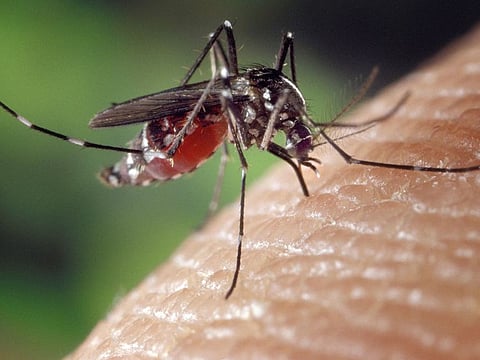Mosquitoes are poised to swamp global health systems
Widespread outbreak of a non-endemic disease would be enough to overwhelm health systems

When you think of dangerous animals, the ones that typically spring to mind have teeth or claws. But what about wings and a proboscis?
In many countries, mosquitoes are nothing more than a nuisance. But in others, they spread tropical diseases that kill at least 700,000 people a year — more than any other animal, according to estimates from the World Health Organisation. Unfortunately, they’re likely to get deadlier. As greenhouse-gas emissions make our planet hotter and wetter, disease-spreading mosquitoes are thriving.
With nations in South America battling some of the worst outbreaks of mosquito-borne disease in decades, the case of a British woman who caught dengue while on holiday in France last summer has sparked warnings about similar outbreaks in countries where insect-carried pestilence hasn’t previously been endemic. Climate change is making tropical diseases everybody’s problem.
Dengue outbreak in 140 countries
Take dengue — sometimes known as “break-bone fever,” which gives you some idea of its symptoms — which has exploded over the past few decades. Cases reported to the WHO increased to 5.2 million in 2019 from just more than 500,000 in 2000. In the 1970s, dengue was endemic in nine countries. Nowadays, about 140 countries deal with outbreaks of dengue regularly. And those outbreaks are getting larger and more severe.
The virus and associated mosquitoes — Aedes aegypti and Aedes albopictus, or the yellow fever and Asian tiger mosquitoes — are not only booming in endemic countries, they’re also pushing into higher altitudes and latitudes. In Europe, the Asian tiger mosquito is now established in all of Italy, much of southern France and eastern Spain. Where the mosquito is, the virus is likely to follow: Sudan has reported dengue cases in the capital city for the first time, and France saw a chain of locally transmitted cases last summer.
Judging by what’s happening in Latin America, 2023 could be even worse. In a WHO press conference at the start of April about the worrying dengue and chikungunya (a related virus spread by the same mosquitoes) epidemics there, Raman Velyayudhan, head of the WHO global programme on the control of neglected tropical diseases, said that trend could continue around the world this year.
Viruses are unpredictable...whenever a vector is present and there is a susceptible population, then there is a risk of large epidemics, if not a pandemic.
It’s not just mosquitoes that are enjoying the warmer temperatures, but a whole host of disease-spreading vectors, including ticks (which carry encephalitis and Lyme disease) and even freshwater snails (schistosomiasis). Higher temperatures and increased humidity and rainfall boost the biting proclivities, reproductive rates and spatial distribution of these hosts.
It’s a problem that’s top of mind for the Wellcome Trust, a global charitable foundation focusing on health. It’s investing in research around climate-change and vector-borne diseases, and has provided 22.7 million ($28 million) for 24 research teams developing digital tools to better predict when infectious-disease outbreaks might occur. One such project is E-Dengue in Vietnam, designed to help health systems prepare for dengue outbreaks up to two months in advance by collating local data. Dung Phung, the lead scientist on the project, said that currently dengue prevention and control is mostly reactive, limiting the effectiveness of measures to combat its spread. An early warning system would help address that.
Vaccines and virus-blocking bacteria
There’s been some progress with vaccines. Nigeria and Ghana have provisionally approved a new malaria vaccine developed by scientists at the University of Oxford, and Japanese drugmaker Takeda Pharmaceutical’s dengue shot is being steadily rolled out around the world.
Another promising tool is a bacteria called Wolbachia. Found in about 50 per cent of insects, it’s been shown to outcompete viruses like dengue, Zika and chikungunya in yellow fever mosquitoes, making them less likely to pass on the disease to humans. One study in Indonesia showed that introducing mosquitoes infected with Wolbachia reduced dengue cases by 77 per cent. The method is now being rolled out nationwide for the first time in Brazil.
But early warning systems and virus-blocking bacteria won’t be magic bullets alone. “The combination of both is what is going to drive the change,” Felipe Coln-Gonzlez, technology lead at the Wellcome Trust, told me. “To be able to apply Wolbachia more effectively, you need to identify hotspots, and it’s through the usage of early warning systems and risk metrics that you can identify them.”
Also Read: A woman diplomat in a man’s world
Also Read: India’s population advantage
Also Read: Britain, Brexit and the Dominic Raab scandal
There are plenty of challenges ahead. Coln-Gonzlez stressed the need for better collaboration between researchers and policymakers, more data collection, and sharing and talent development, especially in low-income countries, which bear the brunt of climate change and tropical disease.
With Covid still fresh on our minds, the obvious question is: “What’s the pandemic risk?” The answer to that is shrouded in uncertainty — viruses are unpredictable — but Diana Rojas Alvarez, co-lead of the WHO’s global arbovirus initiative, noted in a press conference that whenever a vector is present and there is a susceptible population, then there is a risk of large epidemics, if not a pandemic.
A widespread outbreak, especially of a disease that hasn’t historically been endemic, would certainly be enough to overwhelm even the health systems of high-income countries, as the Covid-19 pandemic demonstrated with tragic consequences. As Coln-Gonzlez says: “If we don’t pay attention, it will happen again.”
— Bloomberg
Lara Williams is a Bloomberg Opinion columnist covering climate change.
Sign up for the Daily Briefing
Get the latest news and updates straight to your inbox



